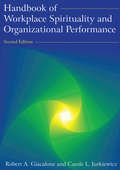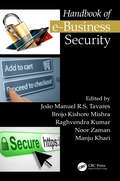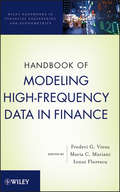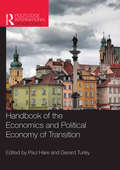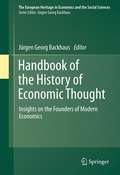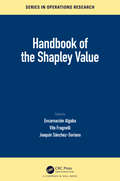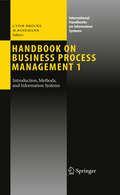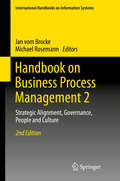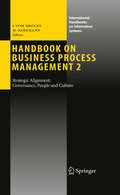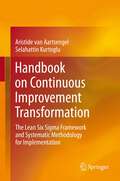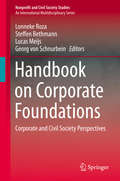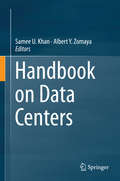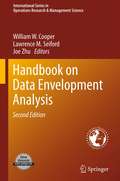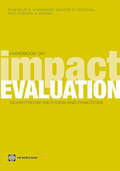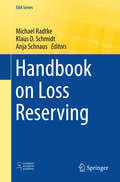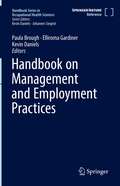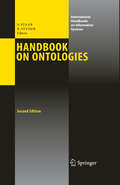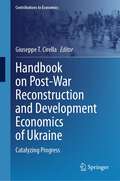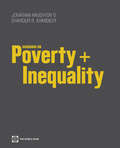- Table View
- List View
Handbook of Workplace Spirituality and Organizational Performance
by Robert A Giacalone Carole L. JurkiewiczAn explanation of how and why the economic downturn of 2007 became the Great Recession of 2008 and 2009. It explores the root causes of the cycle of boom and bust of the economy. It describes social equity in terms of its arguments and claims in political, economic, and social circumstances.
Handbook of e-Business Security
by Raghvendra Kumar João Manuel Tavares Manju Khari Brojo Kishore Mishra Noor ZamanThere are a lot of e-business security concerns. Knowing about e-business security issues will likely help overcome them. Keep in mind, companies that have control over their e-business are likely to prosper most. In other words, setting up and maintaining a secure e-business is essential and important to business growth. This book covers state-of-the art practices in e-business security, including privacy, trust, security of transactions, big data, cloud computing, social network, and distributed systems.
Handbook of e-Tourism
by Ulrike Gretzel Zheng Xiang Matthias Fuchs Wolfram HöpkenThis handbook provides an authoritative and truly comprehensive overview both of the diverse applications of information and communication technologies (ICTs) within the travel and tourism industry and of e-tourism as a field of scientific inquiry that has grown and matured beyond recognition. Leading experts from around the world describe cutting-edge ideas and developments, present key concepts and theories, and discuss the full range of research methods. The coverage accordingly encompasses everything from big data and analytics to psychology, user behavior, online marketing, supply chain and operations management, smart business networks, policy and regulatory issues – and much, much more. The goal is to provide an outstanding reference that summarizes and synthesizes current knowledge and establishes the theoretical and methodological foundations for further study of the role of ICTs in travel and tourism. The handbook will meet the needs of researchers and students in various disciplines as well as industry professionals. As with all volumes in Springer’s Major Reference Works program, readers will benefit from access to a continually updated online version.
Handbook of modeling high-frequency data in finance
by Frederi G. Viens Maria C. Mariani Ionut FlorescuCUTTING-EDGE DEVELOPMENTS IN HIGH-FREQUENCY FINANCIAL ECONOMETRICS In recent years, the availability of high-frequency data and advances in computing have allowed financial practitioners to design systems that can handle and analyze this information. Handbook of Modeling High-Frequency Data in Finance addresses the many theoretical and practical questions raised by the nature and intrinsic properties of this data. A one-stop compilation of empirical and analytical research, this handbook explores data sampled with high-frequency finance in financial engineering, statistics, and the modern financial business arena. Every chapter uses real-world examples to present new, original, and relevant topics that relate to newly evolving discoveries in high-frequency finance, such as: Designing new methodology to discover elasticity and plasticity of price evolution Constructing microstructure simulation models Calculation of option prices in the presence of jumps and transaction costs Using boosting for financial analysis and trading The handbook motivates practitioners to apply high-frequency finance to real-world situations by including exclusive topics such as risk measurement and management, UHF data, microstructure, dynamic multi-period optimization, mortgage data models, hybrid Monte Carlo, retirement, trading systems and forecasting, pricing, and boosting. The diverse topics and viewpoints presented in each chapter ensure that readers are supplied with a wide treatment of practical methods. Handbook of Modeling High-Frequency Data in Finance is an essential reference for academics and practitioners in finance, business, and econometrics who work with high-frequency data in their everyday work. It also serves as a supplement for risk management and high-frequency finance courses at the upper-undergraduate and graduate levels.
Handbook of the Economics and Political Economy of Transition (Routledge International Handbooks)
by Gerard Turley Paul HareTransition from central planning to a market economy, involving large-scale institutional change and reforms at all levels, is often described as the greatest social science experiment in modern times. As more than two decades have passed since the fall of the Berlin Wall and the collapse of the Soviet Union, it is now an excellent time to take stock of how the transition process has turned out for the economies that have moved on from socialism and the command economy. This new handbook assembles a team of leading experts, many of whom were closely involved in the transition process as policymakers and policy advisors, to explore the major themes that have characterized the transition process. After identifying the nature of initial conditions and the strengths and weaknesses of institutions, the varying paths and reforms countries have taken are fully analyzed – from the shock therapy, privatization or gradualism of the early years to the burning issues of the present including global integration and sustainable growth. Topics covered include the socialist system pre-transition, economic reforms, institutions, the political economy of transition, performance and growth, enterprise restructuring, and people and transition. The country coverage is also extensive, from the former socialist countries of the USSR and the satellite states of Central and Eastern Europe to the Asian countries of China, Vietnam and others. The rise of China as a key actor in the drama is chronicled, along with the emergence of a new, more confident, oil-rich Russia. The comparative prosperity of the Central European countries such as Poland and the Czech Republic is contrasted with the mixed fortunes of the former USSR, where some countries are stagnating while others boom. This Handbook of the Economics and Political Economy of Transition is the definitive guide to this new order of things in the former Communist world.
Handbook of the History of Economic Thought
by Jürgen BackhausThis reader in the history of economic thought challenges the assumption that today's prevailing economic theories are always the most appropriate ones. As Leland Yeager has pointed out, unlike the scientists of the natural sciences, economists provide their ideas largely to politicians and political appointees who have rather different incentives that might prevent them from choosing the best economic theory. In this book, the life and work of each of the founders of economics is examined by the best available expert on that founding figure. These contributors present rather novel and certainly not mainstream interpretations of the founders of modern economics. The primary theme concerns the development of economic thought as this emerged in the various continental traditions including the Islamic tradition. These continental traditions differed substantially, both substantively and methodologically, from the Anglo-Saxon orientation that has been dominant in the last century for example in the study of public finance or the very construct of the state itself. This books maps the various channels of continental economics, particularly from the late-18th through the early-20th centuries, explaining and demonstrating the underlying unity amid the surface diversity. In particular, the book emphasizes the writings of John Stuart Mill, his predecessor David Ricardo and his follower Jeremy Bentham; the theory of Marginalism by von Thünen, Cournot, and Gossen; the legacy of Karl Marx; the innovations in developmental economics by Friedrich List; the economic and monetary contributions and "struggle of escape" by John Maynard Keynes; the formidable theory in public finance and economics by Joseph Schumpeter; a reinterpretation of Alfred Marshall; Léon Walras, Heinrich von Stackelberg, Knut Wicksell, Werner Sombart, and Friedrich August von Hayek are each dealt with in their own right.
Handbook of the Philosophical Foundations of Business Ethics
by Christoph LuetgeThe Handbook of Business Ethics: Philosophical Foundations is a standard interdisciplinary reference handbook in the field of business ethics. Articles by notable philosophers and economists examine fundamental concepts, theories and questions of business ethics: Are morality and self-interest compatible? What is meant by a just price? What did the Scholastic philosophers think about business? The handbook will cover the entire philosophical basis of business ethics. Articles range from historical positions such as Aristotelianism, Kantianism and Marxism to systematic issues like justice, religious issues, rights and globalisation or gender. The book is intended as a reference work for academics, students (esp. graduate), and professionals.
Handbook of the Philosophy of Climate Change (Handbooks in Philosophy)
by Marcello Di Paola Gianfranco PellegrinoThis Handbook offers a broad yet unified treatment of many philosophical issues connected with climate change, ranging from foundational puzzles to detailed applications. It extends to many branches of philosophy that are relevant to the understanding of the premises and implications of the impacts of climate change on human and nonhuman life on Earth. More specifically, the handbook examines the scientific accounts of climate change as well as its causes. It explores the tools offered by social sciences and humanities to study the societal premises and impacts of climate change as well as delving deeper into the ethical and political issues connected with and resulting from climate change. By doing so, it puts it all in an ecological and historical context. In addition, the book offers solutions to some important philosophical puzzles and problems, and indicates paths of interaction between philosophy and other disciplines. The discussion about climate change and the mitigation/adaptation policies spans many areas and levels – from abstract science and philosophy to current on-the-ground politics. However, climate change is also a great a philosophical puzzle. Indeed, its existential and practical relevance can be thought to largely derive from the philosophical complications it engenders. Climate change is applied philosophy par excellence. Preventing dangerous anthropogenic climate change needs very good philosophy applied to concrete and specific practical issues. Climate change is an area where scholars from very different provenances should cooperate on equal terms, having in view a common, and really important, purpose – contribute to preventing great burdens and even the extinction of humankind and the destruction of hospitable and valuable non-human nature.
Handbook of the Shapley Value (Chapman & Hall/CRC Series in Operations Research)
by Encarnación Algaba, Vito Fragnelli and Joaquín Sánchez-SorianoHandbook of the Shapley Value contains 24 chapters and a foreword written by Alvin E. Roth, who was awarded the Nobel Memorial Prize in Economic Sciences jointly with Lloyd Shapley in 2012. The purpose of the book is to highlight a range of relevant insights into the Shapley value. Every chapter has been written to honor Lloyd Shapley, who introduced this fascinating value in 1953. The first chapter, by William Thomson, places the Shapley value in the broader context of the theory of cooperative games, and briefly introduces each of the individual contributions to the volume. This is followed by a further contribution from the editors of the volume, which serves to introduce the more significant features of the Shapley value. The rest of the chapters in the book deal with different theoretical or applied aspects inspired by this interesting value and have been contributed specifically for this volume by leading experts in the area of Game Theory. Chapters 3 through to 10 are more focused on theoretical aspects of the Shapley value, Chapters 11 to 15 are related to both theoretical and applied areas. Finally, from Chapter 16 to Chapter 24, more attention is paid to applications of the Shapley value to different problems encountered across a diverse range of fields. As expressed by William Thomson in the Introduction to the book, "The chapters contribute to the subject in several dimensions: Mathematical foundations; axiomatic foundations; computations; applications to special classes of games; power indices; applications to enriched classes of games; applications to concretely specified allocation problems: an ever-widening range, mapping allocation problems into games or implementation." Nowadays, the Shapley value continues to be as appealing as when it was first introduced in 1953, or perhaps even more so now that its potential is supported by the quantity and quality of the available results. This volume collects a large amount of work that definitively demonstrates that the Shapley value provides answers and solutions to a wide variety of problems.
Handbook on Business Process Management 1: Introduction, Methods, and Information Systems
by Jan Vom Brocke Michael RosemannBusiness Process Management (BPM) has become one of the most widely used approaches for the design of modern organizational and information systems. The conscious treatment of business processes as significant corporate assets has facilitated substantial improvements in organizational performance but is also used to ensure the conformance of corporate activities. This Handbook presents in two volumes the contemporary body of knowledge as articulated by the world' s leading BPM thought leaders. This first volume focuses on arriving at a sound definition of Business Process Management approaches and examines BPM methods and process-aware information systems. As such, it provides guidance for the integration of BPM into corporate methodologies and information systems. Each chapter has been contributed by leading international experts. Selected case studies complement these views and lead to a summary of BPM expertise that is unique in its coverage of the most critical success factors of BPM.
Handbook on Business Process Management 2
by Jan Vom Brocke Michael RosemannBusiness Process Management (BPM) has become one of the most widely used approaches for the design of modern organizational and information systems. The conscious treatment of business processes as significant corporate assets has facilitated substantial improvements in organizational performance but is also used to ensure the conformance of corporate activities. This Handbook presents in two volumes the contemporary body of knowledge as articulated by the world's leading BPM thought leaders. This second volume focuses on the managerial and organizational challenges of Business Process Management such as strategic and cultural alignment, governance and the education of BPM stakeholders. As such, this book provides concepts and methodologies for the integration of BPM. Each chapter has been contributed by leading international experts. Selected case studies complement their views and lead to a summary of BPM expertise that is unique in its coverage of the most critical success factors of BPM.
Handbook on Business Process Management 2: Strategic Alignment, Governance, People and Culture
by Jan Vom Brocke Michael RosemannBusiness Process Management (BPM) has become one of the most widely used approaches for the design of modern organizational and information systems. The conscious treatment of business processes as significant corporate assets has facilitated substantial improvements in organizational performance but is also used to ensure the conformance of corporate activities. This Handbook presents in two volumes the contemporary body of knowledge as articulated by the world's leading BPM thought leaders. This second volume focuses on the managerial and organizational challenges of Business Process Management such as strategic and cultural alignment, governance and the education of BPM stakeholders. As such, this book provides concepts and methodologies for the integration of BPM. Each chapter has been contributed by leading international experts. Selected case studies complement their views and lead to a summary of BPM expertise that is unique in its coverage of the most critical success factors of BPM.
Handbook on Continuous Improvement Transformation: The Lean Six Sigma Framework and Systematic Methodology for Implementation
by Selahattin Kurtoglu Aristide Van AartsengelThis handbook provides a comprehensive and detailed framework for the implementation of "Continuous Improvement" and Lean Six Sigma in a professional project management environment. For this purpose the book brings together Lean Six Sigma and the PMBOK standard for project management. It provides an integrated approach, which can be used for both transactional and manufacturing businesses to better define ways to reduce costs, enhance processes ,and achieve faster implementation and new product or service development. The reader is guided carefully and reliably through the detailed procedures introduced in this book using a comprehensive, conceptual and practical well-balanced approach.
Handbook on Corporate Foundation: Corporate and Civil Society Perspectives (Nonprofit and Civil Society Studies)
by Steffen Bethmann Lonneke Roza Lucas Meijs Georg Von SchnurbeinCompanies increasingly play a meaningful role in civil society and the philanthropic sector through Corporate Social Responsibility (CSR) and Corporate Philanthropy (CP). The most well studied form of allocating these resources is through outright contributions to operating external foundations and other nonprofit organizations. However, far less is known about the use of corporate foundations, separate and independent nonprofit entities aimed at channeling corporate giving to a social mission related to a company. Corporate foundations are often linked to the founding company through their name, funding, trustees, administration and potential employee involvement. As these foundations are growing in number, size and importance and becoming increasingly visible in the philanthropic sector, the urgency to understand their role and functioning becomes more important.The primary aim of this volume is to deliver a holistic analysis of the current state-of-the-art on corporate foundations. For that reason, the book includes different perspectives on and use a hybrid concept of corporate foundations. The book includes three main parts. First, looking further into the organizational processes of corporate foundations, the book analyzes governance and operations as major aspects of organizational performance. Second, it sheds light on the role of corporate foundations in various institutional settings. Lastly, the book includes various stakeholder perspectives on corporate foundations, including corporate employees, beneficiaries, and their non-profit partners. By reading the book, readers will build a comprehensive understanding of the role and functioning of corporate foundations, understand new avenues for research and, in case they are practitioners in the field, find practical advice rooted in academic research.
Handbook on Data Centers
by Albert Y. Zomaya Samee U. KhanThis handbook offers a comprehensive review of the state-of-the-art research achievements in the field of data centers. Contributions from international, leading researchers and scholars offer topics in cloud computing, virtualization in data centers, energy efficient data centers, and next generation data center architecture. It also comprises current research trends in emerging areas, such as data security, data protection management, and network resource management in data centers. Specific attention is devoted to industry needs associated with the challenges faced by data centers, such as various power, cooling, floor space, and associated environmental health and safety issues, while still working to support growth without disrupting quality of service. The contributions cut across various IT data technology domains as a single source to discuss the interdependencies that need to be supported to enable a virtualized, next-generation, energy efficient, economical, and environmentally friendly data center. This book appeals to a broad spectrum of readers, including server, storage, networking, database, and applications analysts, administrators, and architects. It is intended for those seeking to gain a stronger grasp on data center networks: the fundamental protocol used by the applications and the network, the typical network technologies, and their design aspects. The Handbook of Data Centers is a leading reference on design and implementation for planning, implementing, and operating data center networks.
Handbook on Data Envelopment Analysis
by Joe Zhu William W. Cooper Lawrence M. SeifordThis handbook covers DEA topics that are extensively used and solidly based. The purpose of the handbook is to (1) describe and elucidate the state of the field and (2), where appropriate, extend the frontier of DEA research. It defines the state-of-the-art of DEA methodology and its uses. This handbook is intended to represent a milestone in the progression of DEA. Written by experts, who are generally major contributors to the topics to be covered, it includes a comprehensive review and discussion of basic DEA models, which, in the present issue extensions to the basic DEA methods, and a collection of DEA applications in the areas of banking, engineering, health care, and services. The handbook's chapters are organized into two categories: (i) basic DEA models, concepts, and their extensions, and (ii) DEA applications. First edition contributors have returned to update their work. The second edition includes updated versions of selected first edition chapters. New chapters have been added on: different approaches with no need for a priori choices of weights (called "multipliers) that reflect meaningful trade-offs, construction of static and dynamic DEA technologies, slacks-based model and its extensions, DEA models for DMUs that have internal structures network DEA that can be used for measuring supply chain operations, Selection of DEA applications in the service sector with a focus on building a conceptual framework, research design and interpreting results.
Handbook on Economics of Discrimination and Affirmative Action
by Ashwini DeshpandeThis Handbook deals with theoretical and empirical evidence on the economics of discrimination and affirmative action across the world, assessed over a variety of social identities, such as caste, race, ethnicity, gender, disability, age, tribal status. It also outlines methodological advances in this area, with plenty of additional references for the interested reader. It combines theoretical frameworks developed in the West with historical writings about discrimination and social justice from primarily Indian philosophers, aspects which are typically not found under one roof. It offers the reader a combination of insights into theories across a range of disciplines, as well as evidence, data –both quantitative and qualitative, in addition to the latest methodological advances in the estimation of discrimination – econometric, experimental, mixed-methods.
Handbook on Hospital Planning & Designing: For Medical Administrators, Architects, Planners and Students
by Ajay GargThis handbook is in reference to the book "Manual of Hospital Planning and Designing" which was earlier published by Springer Nature.This "Handbook on Hospital Planning and Designing" is a helpful guide that shows how to build an efficient healthcare project. Carefully planning and designing hospitals is essential to deliver and effective healthcare facilities. It's basically a mix of art, science, and caring. This book highlights the rooms, spaces, MEP service, safety, security, equipment, instruments, and other support services.This book is a summary of the essentials for designers and planners who want to design hospitals. Architects, designers, doctors, and people who are involved in the designing of hospital, will find it useful. It helps them make places that work well, look nice, and care for patients best. Setting up the hospital project is more than just building. It's about creating places where people get better and feel good.This book explores everything about planning and designing hospitals in the given chapters from the beginning, covering all the departments until the hospital is all set up. This book is helpful for experienced architects with new ideas, a healthcare worker who wants the best for patients, or a student who loves learning about hospitals.
Handbook on Impact Evaluation: Quantitative Methods and Practices
by Shahidur R. Khandker Gayatri B. Koolwal Hussain A. SamadPublic programs are designed to reach certain goals and beneficiaries. Methods to understand whether such programs actually work, as well as the level and nature of impacts on intended beneficiaries, are main themes of this book. Has the Grameen Bank, for example, succeeded in lowering consumption poverty among the rural poor in Bangladesh? Can conditional cash transfer programs in Mexico and Latin America improve health and schooling outcomes for poor women and children? Does a new road actually raise welfare in a remote area in Tanzania, or is it a 'highway to nowhere'? This book reviews quantitative methods and models of impact evaluation. It begins by reviewing the basic issues pertaining to an evaluation of an intervention to reach certain targets and goals. It then focuses on the experimental design of an impact evaluation, highlighting its strengths and shortcomings, followed by discussions on various non-experimental methods. The authors also cover methods to shed light on the nature and mechanisms by which different participants are benefiting from the program. For researchers interested in learning how to use these models with statistical software, the book also provides STATA exercises in the context of evaluating major microcredit programs in Bangladesh, such as the Grameen Bank. The framework presented in this book can be very useful for strengthening local capacity in impact evaluation among technicians and policymakers in charge of formulating, implementing, and evaluating programs to alleviate poverty and underdevelopment.
Handbook on Loss Reserving (EAA Series)
by Michael Radtke Klaus D. Schmidt Anja SchnausThis handbook presents the basic aspects of actuarial loss reserving. Besides the traditional methods, it also includes a description of more recent ones and a discussion of certain problems occurring in actuarial practice, like inflation, scarce data, large claims, slow loss development, the use of market statistics, the need for simulation techniques and the task of calculating best estimates and ranges of future losses. In property and casualty insurance the provisions for payment obligations from losses that have occurred but have not yet been settled usually constitute the largest item on the liabilities side of an insurer's balance sheet. For this reason, the determination and evaluation of these loss reserves is of considerable economic importance for every property and casualty insurer. Actuarial students, academics as well as practicing actuaries will benefit from this overview of the most important actuarial methods of loss reserving by developing an understanding of the underlying stochastic models and how to practically solve some problems which may occur in actuarial practice.
Handbook on Management and Employment Practices (Handbook Series in Occupational Health Sciences #3)
by Paula Brough Kevin Daniels Elliroma GardinerThis handbook focuses on the contribution of management and employment practices to the health and wellbeing of workers. It provides readers with a comprehensive oversight of the latest research and thinking on these issues, with content provided by leading researchers in each of the fields covered. This reference work is divided into six sections that cover leadership, change management, human resource management practices, managing disabilities, work-life interfaces, and emerging challenges. The topics covered represent an interdisciplinary perspective, integrating psychology, social sciences, biomedical sciences, economics, employment relations and management. Through a spectrum of chapters this volume provides the best available scientific evidence to professionals and stakeholders on the interplay between management practices, health and wellbeing.
Handbook on Marine Environment Protection
by Till Markus Markus SalomonThis handbook is the first of its kind to provide a clear, accessible, and comprehensive introduction to the most important scientific and management topics in marine environmental protection. Leading experts discuss the latest perspectives and best practices in the field with a particular focus on the functioning of marine ecosystems, natural processes, and anthropogenic pressures. The book familiarizes readers with the intricacies and challenges of managing coasts and oceans more sustainably, and guides them through the maze of concepts and strategies, laws and policies, and the various actors that define our ability to manage marine activities. Providing valuable thematic insights into marine management to inspire thoughtful application and further study, it is essential reading for marine environmental scientists, policy-makers, lawyers, practitioners and anyone interested in the field.
Handbook on Ontologies
by Rudi Studer Steffen StaabAn ontology is a formal description of concepts and relationships that can exist for a community of human and/or machine agents. The notion of ontologies is crucial for the purpose of enabling knowledge sharing and reuse. The Handbook on Ontologies provides a comprehensive overview of the current status and future prospectives of the field of ontologies considering ontology languages, ontology engineering methods, example ontologies, infrastructures and technologies for ontologies, and how to bring this all into ontology-based infrastructures and applications that are among the best of their kind. The field of ontologies has tremendously developed and grown in the five years since the first edition of the "Handbook on Ontologies". Therefore, its revision includes 21 completely new chapters as well as a major re-working of 15 chapters transferred to this second edition.
Handbook on Post-War Reconstruction and Development Economics of Ukraine: Catalyzing Progress (Contributions to Economics)
by Giuseppe T. CirellaThis authoritative handbook offers insights into the complexities of post-war reconstruction and development economics in Ukraine. Covering a broad spectrum of topics, from bolstering national security to fostering sustainable economic growth, it offers a comprehensive understanding of the economic dynamics, factors, and practical applications shaping policy and programs.The book explores the multifaceted requirements for enhancing fiscal, economic, and social aspects, including security, education, working conditions, domestic and international policies, and market conditions. Using traditional and innovative analytical tools, it unravels the complex relationship between macroeconomic and microeconomic factors in Ukraine's post-war landscape, charting a path towards economic growth. Key themes within this handbook encompass development data, statistical capacity building, research and knowledge creation, national indicators, and impact evaluation. An indispensable reference for Ukraine's future and a must-read for researchers and policy analysts focused on Eastern European economies, this handbook illuminates the journey from war-torn nations to more prosperous ones.
Handbook on Poverty and Inequality
by Jonathan Haughton Shahidur R. KhandkerHandbook on Poverty and Inequality was originally designed to support training courses in poverty analysis and inequality. The Handbook begins with an explanatory text that includes numerous examples, multiple-choice questions to ensure active learning, and extensive practical exercises that use Stata statistical software. The Handbook will help researchers and evaluators in charge of preparing background materials for Poverty Reducation Strategy Papers (PRSPs) and those responsible for monitoring and evaluating poverty reduction programs and policies. The World Bank Institute has used the Handbook in training workshops in countries from Bangladesh, India, and Pakistan, to Cambodia, Indonesia, the Philippines, and Thailand, to Malawi and Tanzania, as well as in university courses on poverty and in distance education courses with participants from Asian and African countries. The Handbook has also been used in an online asynchronous course with more than 200 participants worldwide. Using the feedback from these courses, the authors have created a clearly-written text that balances rigor with practicality. The Handbook is designed to be accessible to people with a university-level background in science or the social sciences. It is an invaluable tool for policy analysts, researchers, college students, and government officials working on policy issues related to poverty and inequality.
